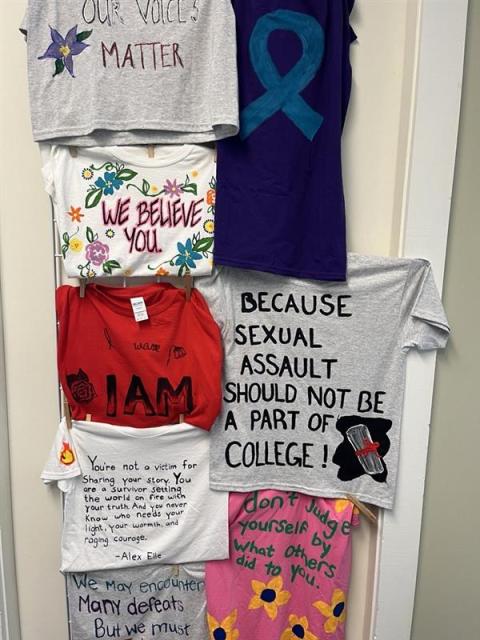What is Rape Culture?
Rape culture exists when interpersonal violence is both prevalent and normalized.

Prevalent = widespread, happening often.
Normalized = taken for granted, something we are accustomed to despite it being considered unacceptable or objectionable.
How does interpersonal violence become normalized?
Normalization is a social process; it requires a certain level of human involvement and momentum. What does that look like when it comes to IPV? Consider...
- Prevailing attitudes and norms that minimize, dismiss, and make light of violence
- Victim blaming; when violence & harm are seen as matters of a potential victim/survivor's personal responsibility
- A lack of meaningful accountability for those who cause harm or perpetrate violence
- The acceptance of stereotypes and myths that create the dominant narrative about what kinds of violence are valid, or which kinds of survivors (or perpetrators) are credible
Rape Myths vs. Facts
Rape culture doesn’t exist by accident. It is upheld and perpetuated by misguided attitudes and beliefs about violence, identity, victimization, and perpetration. These attitudes and beliefs are called “rape myths.” Research shows that in communities with high acceptance of these myths, we also see higher rates of interpersonal violence (sexual assault, harassment, stalking, & relationship abuse).
Rape myths are all around us, and they can show up in subtle and insidious ways. For instance, someone might not directly tell a survivor that they are to blame for what happened to them, but they may ask a question like “had you been drinking?” or “were you being flirtatious?” These kinds of inquiries imply that survivors’ own behaviors caused the violence, rather than placing responsibility on perpetrators.
- Myth: If you wear revealing clothing, you’re asking for unwanted attention.
- Fact: No choice of clothing is an invitation for unwanted sexual contact. We get to decide when we are sexual – not other people. Assault is assault, regardless of how someone is dressed. How someone chooses to dress is a matter of self-expression and bodily autonomy – everyone should have the freedom to wear what they feel best in.
-
Myth: Most assaults are committed by violent & dangerous strangers.
- Fact: 9 out of 10 assaults are perpetrated by someone known to the victim, such as a friend, classmate, family member, or partner. Sometimes physically violent tactics are used, but pressure and force can also be applied through words, body language, or substances such as alcohol.
-
Myth: If you had really experienced violence, you would… [be acting hysterical] [have bruises] [have fought back] [have told the police] [etc.]
- Fact: The way someone behaves during or after a traumatic experience is highly individualized and the decisions they make in the aftermath are based on tons of different factors. There is no “right” or “wrong” way to cope with or respond to violence.
-
Myth: Men can’t be sexually assaulted.
- Fact: Anyone can be a survivor of violence, regardless of identity. About 6% of men experience sexual violence while they’re in college[1], yet the stigma they face can present barriers to disclosing, coping, and healing. Click here for more information about myths & facts around this dynamic.
Rape Culture in Society
Rape culture shows up in varied contexts, including media, pop culture, politics, criminal justice, and advertising. It is perpetuated in our schools, homes, workplaces, and religious institutions. We are all socialized in rape culture. Here is a (non-exhaustive) list of ways that rape culture is maintained in society:
- The objectification and policing of bodies (size, shape, appearance, clothing, gender expression, body language)
- Gratuitous violence or assault as a plot device in movies, books, and TV shows
- Lack of accountability for private citizens and public figures who perpetrate harm & violence
- Jokes and humor that use violence as the punchline
- Promotion of myths about false reporting
- Victim-blaming logic and lines of questioning in court proceedings
- Cultures of rampant violence in specific industries (ex: Hollywood, professional sports)
- News media that undermines survivors’ credibility & sympathizes with harm-doers
Rape Culture in College
People ages 18-25 experience interpersonal violence at higher rates than other age demographics[2], and sexual violence on campus has been characterized as an “epidemic.” People often point to the behaviors, habits, and social lives of college students to explain these statistics. But the high rates of campus sexual assault are not inevitable. They are preventable. We all have a role to play in creating a UNH that is free from rape culture, and free from violence.
Disrupting Rape Culture
Since rape culture is present in our daily lives, dismantling rape culture is a daily responsibility. We can and must disrupt rape culture on individual, interpersonal, community, and societal levels. This can be achieved through education, calling out harmful language, myth-busting false beliefs, public support of survivors, direct action and protest, policy advocacy, voting, awareness campaigns, resource mobilization, and so much more. Here are some places to start:
- Examine potential for transformation in your own beliefs, attitudes, and behaviors
- Avoid language that objectifies, dehumanizes, and sexualizes other people
- Pursue education through academic classes, books, podcasts, documentaries, articles, etc.
- Challenge victim-blaming comments, questions, and attitudes
- Communicate openly with partners and never assume consent
- Call out jokes that use sexual violence or survivors as the punchline
- Set an example using active bystander behaviors
- Call your senators; advocate against policies that hurt survivors or protect perpetrators
- Reject rigid gender norms and stereotypes about femininity & masculinity
There is so much more to learn about this topic. If you think that your community, org, class, chapter, team, etc. could benefit from a workshop about rape culture, request The SHARPP Center's "Living in a Rape Culture" program!
[1] https://www.ojp.gov/pdffiles1/nij/grants/221153.pdf
[2] https://www.cdc.gov/violenceprevention/pdf/2015data-brief508.pdf